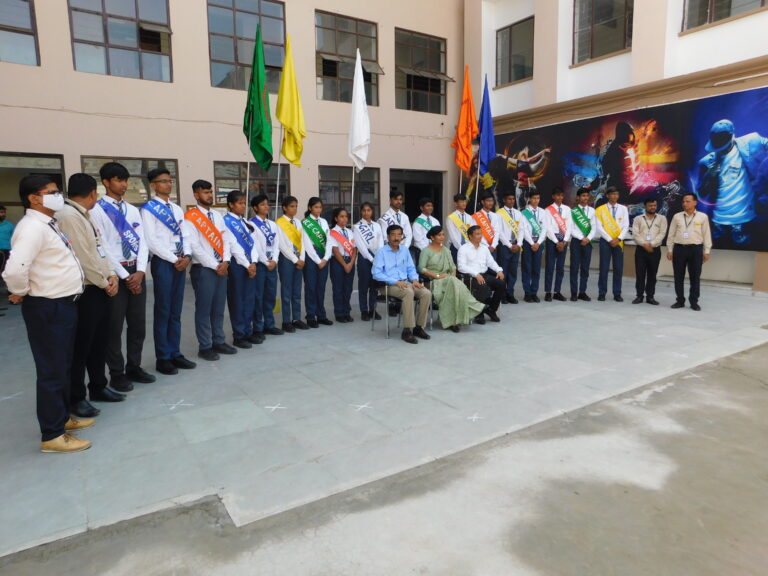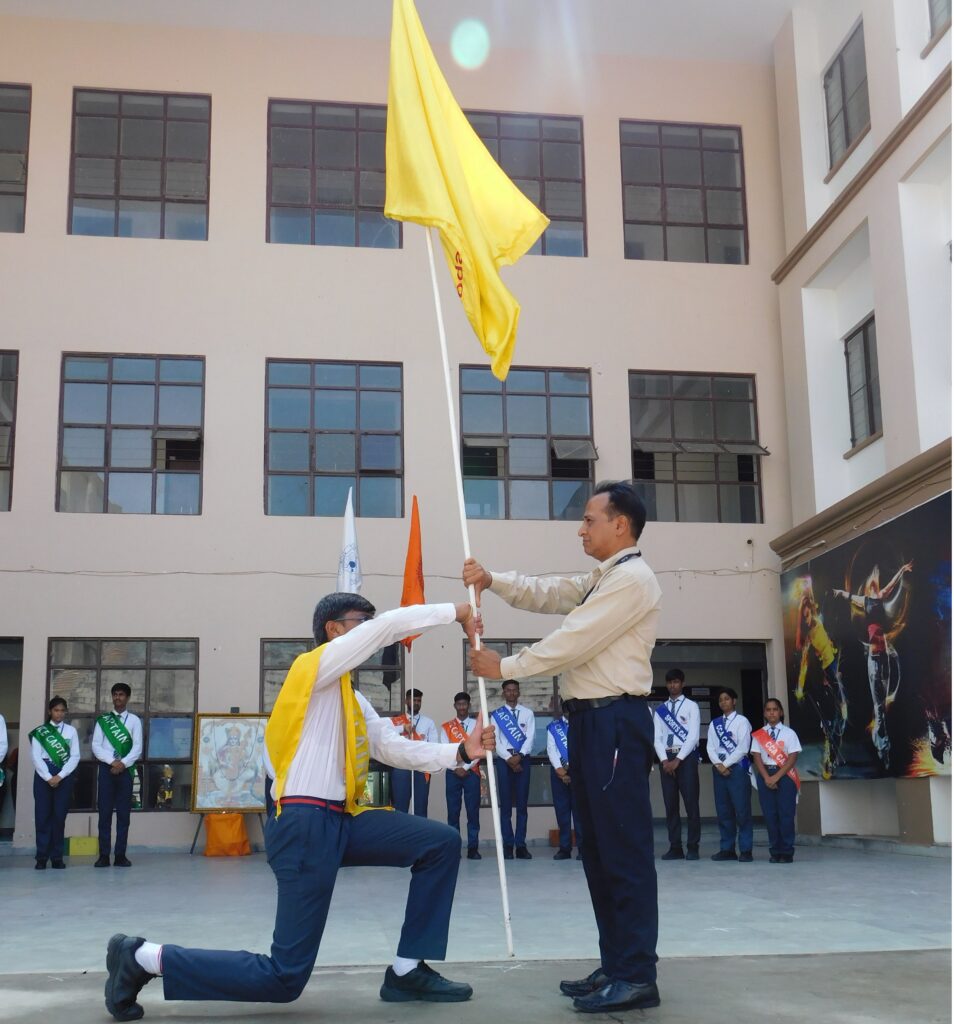Investiture Ceremony in Schools – Meaning, Significance, Anchoring Tips & Format”
Shailendra Porwal
- August 6, 2023
- 12 min read
- 193 Views

What is an “Investiture Ceremony”
An investiture ceremony in schools is a formal event during which students are bestowed with positions of authority and responsibility. These positions may include school prefects, student council members, house captains, or other leadership roles. The ceremony is marked by the handing over of symbolic items like badges, sashes, or ties, which serve as visible representations of the bestowed responsibilities.
In the realm of educational institutions, traditions and ceremonies play a vital role in shaping the school culture and fostering a sense of belonging among students, teachers, and staff. One such important event is the “investiture ceremony school event”, which holds immense significance in schools across the globe. This article aims to delve into the depth of understanding the power of symbols and the impact of an investiture ceremony in the context of educational institutions.
The Power of Symbols in Schools
Symbols hold great meaning and influence in educational settings, especially during an investiture ceremony. Let’s explore how symbols empower the investiture ceremony in schools.
1. Instilling Responsibility
Symbols like badges and sashes given during the investiture ceremony carry the weight of responsibility. When students receive these symbols, they understand that they are entrusted with specific duties to uphold the school’s values, discipline, and academic standards. This sense of responsibility encourages them to act as role models for their peers.
2. Fostering Leadership
The investiture ceremony is a platform to recognize and nurture leadership qualities among students. “student council investiture” By honoring students with leadership positions, the school reinforces the importance of leadership and provides them with opportunities to develop essential leadership skills.
3. Building School Spirit
Symbols are essential in building and strengthening school spirit and identity. When students wear their badges or sashes, it creates a sense of pride and unity. The investiture ceremony becomes a collective celebration of the school’s achievements and a showcase of its vibrant culture.
4. Promoting Accountability
The symbolic representation of authority comes with accountability. Students who receive positions during the investiture ceremony understand that their actions and decisions reflect on the school’s reputation. This sense of accountability helps them make responsible choices.

The Significance of Investiture Ceremonies in Schools
The investiture ceremony is not merely a ritual; it has a profound impact on the overall school environment.
1. Student Engagement
Investiture ceremonies engage students in school life beyond academics. They offer a chance for students to actively participate and take pride in their school’s traditions. Engaged students are more likely to be motivated and committed to their studies and extracurricular activities.
2. Encouraging Positive Behavior
When students witness their peers receiving recognition during the investiture ceremony, it reinforces the values of hard work, dedication, and positive behavior. This positive reinforcement encourages other students to emulate these qualities.
3. Strengthening Teacher-Student Relationships
The investiture ceremony allows teachers to interact with students outside the classroom setting. This informal interaction helps build stronger bonds between students and teachers, fostering a supportive learning environment.
4. Parental Involvement
Investiture ceremonies often involve parents, giving them an opportunity to witness their child’s achievements and involvement in school activities. Parental involvement in such events enhances the parent-school partnership, benefiting the overall development of students.
Planning a Successful Investiture Ceremony
To ensure a meaningful and impactful investiture ceremony in schools, careful planning and execution are necessary. In schools across the world, fostering a sense of community and healthy competition among students is of paramount importance. One way educational institutions achieve this is by creating a house system, where all students are assigned to different houses.
These houses are often named after colors, mountains, rivers, great freedom fighters, or distinguished personalities, depending on the school’s unique identity and values. The house system serves as a foundation for various inter-house activities and competitions, culminating in the much-anticipated investiture ceremony. This article aims to guide schools in planning a successful investiture ceremony, a pivotal event that not only recognizes student leadership but also strengthens the bond among students, teachers, and the entire school community.
1. Selection Process
The selection process for the investiture ceremony in schools is a crucial and comprehensive procedure that aims to identify students with the right attributes and potential to take up leadership roles and responsibilities. The process can vary from one school to another based on their specific criteria and values. However, some common elements that are often considered during the selection process include academic performance, extracurricular involvement, and leadership potential. Let’s delve into each aspect in detail:
2. Academic Performance:
Academic performance serves as an essential criterion for the investiture ceremony. Schools typically look for students who consistently demonstrate strong academic abilities and maintain a good academic record. They may consider factors such as overall GPA, subject-specific grades, and disciplinary history. Candidates with a track record of academic excellence are more likely to be considered for leadership positions as it reflects their commitment to learning and responsibility.
3. Extracurricular Involvement:
Schools also value students who actively participate in extracurricular activities beyond academics. These activities can include sports, arts, cultural events, debate clubs, community service, and more. Students involved in such activities showcase their versatility, teamwork, time management skills, and dedication. Involvement in extracurriculars indicates a well-rounded personality, which is often sought after in potential leaders.
4. Leadership Potential:
Assessing leadership potential is a critical aspect of the selection process. Schools look for students who display leadership qualities such as effective communication, problem-solving abilities, initiative, and the ability to motivate and inspire others. Past leadership roles in school clubs, student council, or community initiatives can be indicative of leadership potential.
5. Nomination Process:
The initial step in the selection process involves nominations. Teachers, peers, and sometimes students themselves may nominate candidates for leadership positions. Nominees may be shortlisted based on the criteria mentioned above, ensuring that those with the potential to lead are considered.
6. Voting or Selection Committee:
After the nomination stage, some schools conduct a voting process to finalize the investiture ceremony candidates. Students and teachers may vote for their preferred candidates, and the ones with the highest votes in each category or house are selected. In other cases, a selection committee comprising teachers, administrators, and student representatives may review the nominations and make the final decisions.
7. Interviews and Presentations:
In some schools, shortlisted candidates may be called for interviews or asked to give presentations to showcase their leadership abilities further. These interviews or presentations provide an opportunity for the candidates to express their visions and ideas for the school and demonstrate how they can contribute to its growth and development.
8. Balancing Representation:
Schools often strive for a balanced representation of students from different backgrounds, abilities, and interests in their leadership positions. This ensures inclusivity and diversity in decision-making processes.
It is essential to emphasize that the selection process is not solely based on one criterion but rather a holistic evaluation of a student’s overall qualities. Academic excellence, extracurricular involvement, and leadership potential are considered in conjunction to identify the most suitable candidates who can make a positive impact on the school community.
By carefully assessing these aspects and using an inclusive and transparent process, schools can ensure that the investiture ceremony nominees embody the qualities and values that align with the school’s mission and contribute to a thriving and cohesive learning environment.
ALSO VISIT :: “Celebrate the Investiture Ceremony 2026–27 in Style!”
Symbolic Items
Symbolic items play a significant role in the investiture ceremony, as they carry the essence of the positions being conferred and reflect the school’s values. When selecting symbolic items, it is crucial to ensure they align with the roles and responsibilities of the recipients. Custom-made badges or sashes are popular choices as they add a personal touch to the ceremony.
By choosing symbolic items that resonate with the school’s values and the essence of the roles, the investiture ceremony becomes more meaningful and memorable. These items act as constant reminders for the recipients of their responsibilities and encourage them to uphold the school’s principles and standards with pride and dedication.
Guest Speakers
Invite guest speakers, such as alumni or accomplished individuals, to inspire and motivate the students during the ceremony.
Student Involvement
Involve students in the planning and organizing of the investiture ceremony with the help of elected House Masters and Asst House Master from faculty to guide and manage the students committee time to time. This fosters a sense of ownership and pride in the event.
Planning a Successful Investiture Ceremony
Captivating Ceremony
A captivating investiture ceremony is one that is meticulously planned and executed to engage the audience and leave a lasting impact on everyone present. Let’s break down the components that contribute to making the ceremony captivating:
1. Distinguished Guests and Dignitaries:
The presence of esteemed chief guests, directors, principals, or special invitees adds a sense of importance and prestige to the ceremony. Their participation in conferring the badges and sashes symbolizes the school’s endorsement of the newly appointed leaders.
2. Orderly Presentation of Badges and Sashes:
The ceremony typically begins with the distribution of badges to the house (badges and sashes in investiture) masters and other staff members, followed by the conferring of badges to the head boy, head girl, captains, and vice-captains. This orderly presentation builds anticipation and sets the tone for the rest of the event.
3. Symbolic Representation:
As each badge and sash is handed over to the recipients, it represents the transfer of authority and responsibility. The symbolic nature of the items reinforces the significance of the positions and motivates the leaders to perform their roles diligently.
4. House Flags and Oath-Taking:
Providing house flags to the house heads during the ceremony is a moment of pride and honor. This act signifies the commencement of their leadership journey. Following the flag presentation, the leaders often take an oath, pledging their commitment to uphold the school’s values and serve the student body and the institution.



5. Cultural Programs and Speeches:
To keep the ceremony engaging and entertaining, cultural programs, such as dance performances, music, or skits, are organized. These performances add vibrancy and showcase the talents of the students. Additionally, inspiring speeches by students, teachers, or special guests can be included, motivating the leaders and the audience alike.
6. Seamless Flow and Transitions:
A captivating ceremony ensures smooth transitions between various segments. Well-rehearsed movements, clear instructions, and coordination among the organizers create a seamless flow, keeping the audience engaged throughout the event.
7. Inclusion of School Community:
Involving the entire school community in the ceremony fosters a sense of unity and pride. Students, teachers, parents, and staff members should all feel connected and invested in the success of the investiture ceremony.
8. Visual and Audio Enhancements:
Incorporating visual aids, like presentations or videos, and using appropriate audio enhancements for announcements and performances can elevate the overall experience and capture the attention of the audience.
9. Closing with a Memorable Moment:
The ceremony should culminate with a memorable moment that leaves a lasting impression. This could be a group photograph of all the newly appointed leaders, a grand finale performance, or a heartfelt closing speech.
By combining these elements, a captivating investiture ceremony ensures that the event is not only a formal recognition of student leadership but also an enjoyable and inspiring experience for everyone involved. Such ceremonies instill pride, motivation, and a sense of responsibility in the student leaders, setting the stage for a successful and impactful leadership term.
Roles and Responsibilities of Student Leaders
Student leaders play a vital role in maintaining discipline, promoting a positive school culture, and inspiring their peers by example. They are entrusted with key responsibilities such as
- Leading school assemblies
- Organizing events
- A assisting teachers in various activities
- Representing the student body during formal occasions.
House captains, head boys/girls, and prefects are expected to uphold school values, encourage teamwork, and support fellow students in both academics and co-curricular activities. Their role goes beyond wearing a badge—it is about demonstrating integrity, leadership, and a willingness to serve the school community with dedication and respect.
Conclusion
The investiture ceremony holds immense significance in schools as a symbol of responsibility, leadership, and school spirit. By embracing the power of symbols and conducting impactful investiture ceremonies, educational institutions can instill a strong sense of belonging, foster leadership qualities, and create a vibrant school culture. These ceremonies serve as a platform to recognize and appreciate students’ contributions, motivating them to excel both academically and personally.
As schools continue to embrace their rich traditions and celebrate the achievements of their students, investiture ceremonies will remain a cornerstone in shaping young minds and preparing them for a bright future.














28 Comments
[…] BACK […]
Hello there, You’ve done an incredible job. I will certainly digg it and personally recommend to
my friends. I’m sure they’ll be benefited from this web site.
Thanks for the auspicious writeup. It in reality was once a leisure account it.
Glance complex to far added agreeable from you!
However, how could we keep up a correspondence?
Very good blog! Do you have any helpful hints for aspiring writers?
I’m planning to start my own site soon but I’m a little lost on everything.
Would you recommend starting with a free platform like
Wordpress or go for a paid option? There are so many options out there that I’m completely overwhelmed ..
Any recommendations? Thanks!
I visit everyday some web pages and sites to read articles or reviews, except
this website provides feature based content.
I’ll right away seize your rss as I can’t in finding your e-mail subscription link
or newsletter service. Do you’ve any? Kindly let me know so that
I may just subscribe. Thanks.
Your way of telling everything in this article is in fact
pleasant, all be capable of effortlessly know it, Thanks
a lot.
Ahaa, its good conversation about this paragraph here at this webpage, I have read
all that, so at this time me also commenting here.
I must thank you for the efforts you’ve put in writing this blog.
I really hope to view the same high-grade content from you in the future as well.
In truth, your creative writing abilities has
inspired me to get my very own site now 😉
Highly descriptive article, I loved that bit. Will there be a part 2?
Thanks to my father who told me on the topic of this weblog, this web
site is in fact remarkable.
I don’t even know how I ended up here, but I thought this post was
good. I do not know who you are but definitely you are going to a
famous blogger if you are not already 😉 Cheers!
Generally I don’t learn article on blogs, but I would like to say that this write-up very compelled me to take a look at and do so!
Your writing taste has been surprised me. Thank you,
very great post.
When I originally left a comment I appear to have clicked
the -Notify me when new comments are added- checkbox and now whenever a
comment is added I get 4 emails with the exact same comment.
Is there an easy method you can remove me from that service?
Appreciate it!
Sure
This is a topic that is close to my heart… Many thanks!
Exactly where are your contact details though?
Pretty great post. I just stumbled upon your blog and
wanted to say that I’ve really enjoyed surfing around your weblog posts.
After all I’ll be subscribing on your feed and I’m hoping you write again very soon!
Remarkable things here. I am very glad to look your post. Thanks a
lot and I’m looking ahead to touch you. Will you kindly drop me a
mail?
Thanks for your view.
Awesome things here. I’m very happy to see your post.
Thank you a lot and I’m having a look ahead to touch you.
Will you please drop me a e-mail?
Hello there, just became aware of your blog through Google, and found that it’s truly informative.
I’m gonna watch out for brussels. I’ll appreciate if you continue this in future.
A lot of people will be benefited from your writing.
Cheers!
Wow, superb blog layout! How long have you been blogging for?
you make blogging look easy. The overall look of your site is
excellent, as well as the content!
Thanks for your concern
Thanks, Plenty of posts.
Reliable posts Many thanks!
Nicely put. Appreciate it.
Great write ups. Cheers.
Regards, I enjoy this!